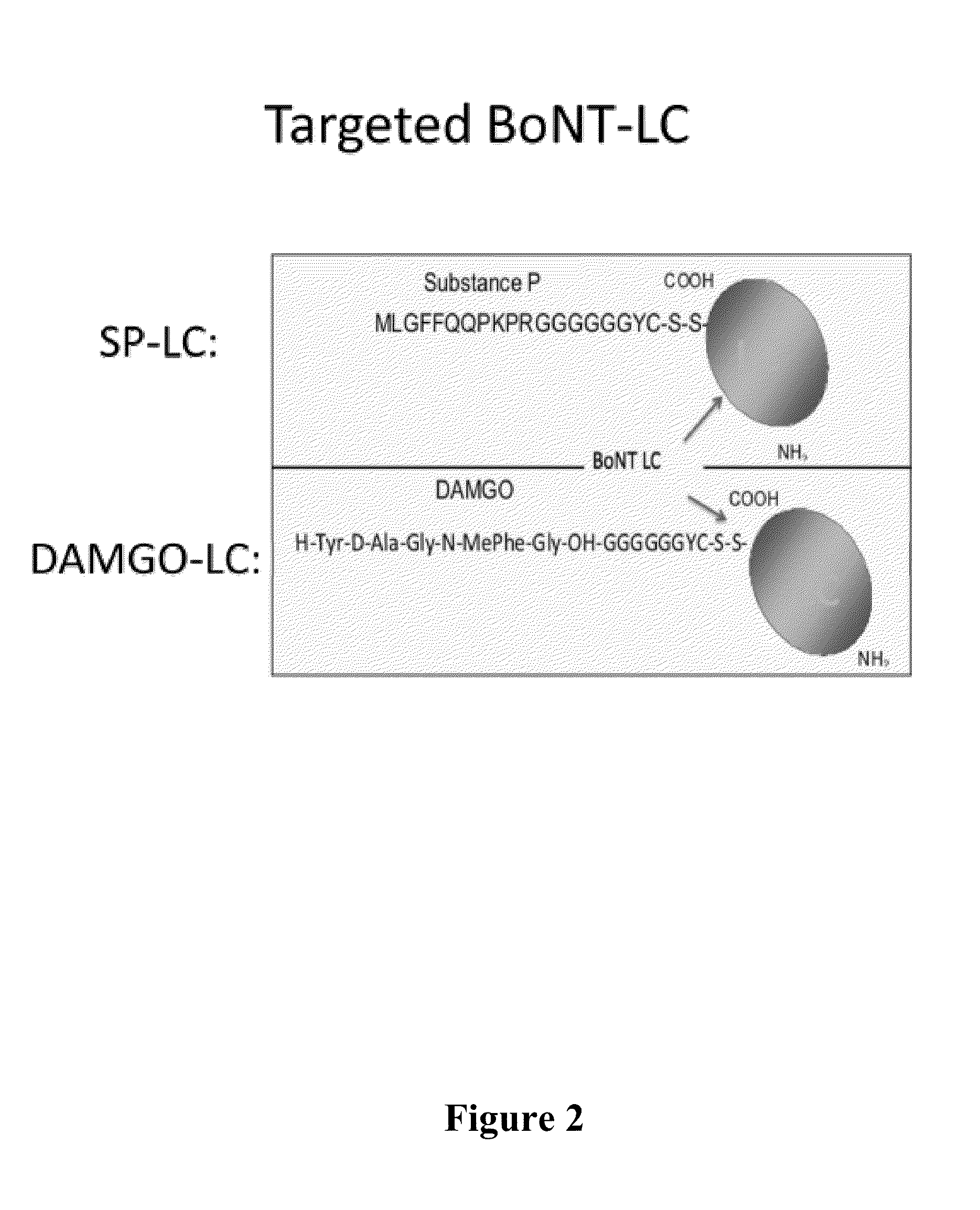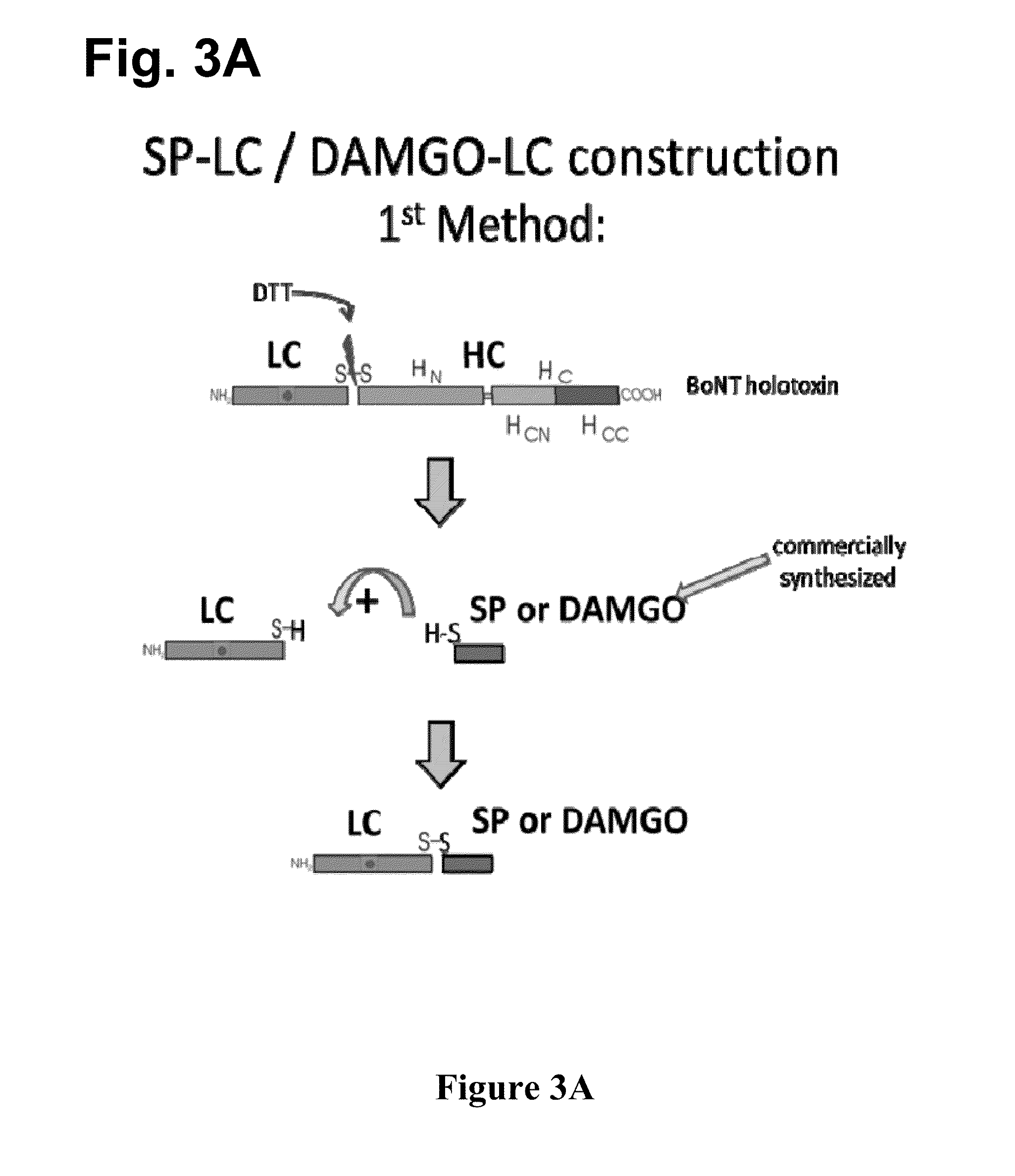Regulation of Specific Spinal Neurons Regulating Pain Transmission
a specific spinal nerve and pain technology, applied in the direction of specific cell targeting, enzyme stabilisation, peptide/protein ingredients, etc., can solve the problems of permanent and irreversible neuron loss, and the treatment of terminal patients, and achieve long-lasting, stable and/or reversible effects
- Summary
- Abstract
- Description
- Claims
- Application Information
AI Technical Summary
Benefits of technology
Problems solved by technology
Method used
Image
Examples
example 1
Recombinant Synthesis in E coli
[0077]In this Example, the sP-LC construct is created by expression of recombinant LC in E. coli, with sequence encoding sP / DAMGO fused to the LC via a thrombin cleavable disulfide linker (Baldwin, et al., 2004; Chen, et al., 2012). This will create an sP or DAMGO-LC construct linked by a single disulfide bond, which can be cleaved inside the endosome after endocytosis, releasing LC into cell. This strategy is similar to the strategy for sP-saporin, leading to cellular intake of saporin (Wiley, et al., 1997; Wiley, et al., 2003).
[0078]In addition, a construct directly fusing the sP or DAMGO sequence to the LC without a disulfide- linker is also created, to determine whether this simpler construct will be equally internalized. Purification and thrombin cleavage will be performed as described (Baldwin, et al., 2004; Chen, et al., 2012). The resulting construct (FIG. 4) will be analyzed by SDS-PAGE gel and immunoblot analyses, alongside BoNT holotoxin. B...
example 2
[0079]This Example provides an alternative way to construct sP-LC, in which the synthesized sP (Bio-Synthesis, Lewisville, Tex.) can also be chemically linked to recombinantly expressed LC by disulfide bonding without affecting their function (Anton, et al., 1991, Wiley, et al., 1997; Wiley, et al., 2003; Wiley, et al., 2007). Specifically, two strategies are described, both of which have been used to make similar constructs of sP-saporin.
[0080]In the first strategy, BoNT-LC is derivatized with SPDP (N-succinimidyl-3-[2-pyridyldithio]propionate), and mono-derivatized LC is selected as described for similar saporin derivatives. (Lappi, et al., 1993). A 5-fold excess of modified sP and DAMGO peptides containing cysteine at the C-terminal end and a 6 glycine linker is added to the LC derivative to allow for conjugation, and excess sP or DAMGO will be removed by dialysis.
[0081]In the second strategy, BoNT LC construct is extended to contain the cysteine 430 at the C-te...
example 3
Creation of Functional Targeted BoNT LC
[0082]The essential deliverable is the LC-peptide constructs (sP-LC; DAMGO-LC). We have two separate rational and robust strategies. The first is expression of constructs based on BoNT / LC (aa 1-425) in E. coli (Baldwin, et al., 2004). While full length LC of BoNT undergoes precipitation and autocatalysis (Ahmed, et al., 2001; Ahmed, et al., 2004; DasGupta, et al., 2005), we have shown that a slightly shortened version is catalytically active and stable. It contains a his6-tag for easy purification (Baldwin, et al., 2004). The Johnson lab developed and used this expression system (Baldwin, et al., 2004). Alternatively, the synthesized sP or a similar peptide can be chemically linked to recombinantly expressed LC by disulfide bonding, which in the case of sP-Saporin, did not affect its function (Wiley, et al., 1997; Wiley, et al., 2003; Wiley, et al., 2007). In recent work, we found that such a sP-LC construct can be created by chemical linkage.
[...
PUM
| Property | Measurement | Unit |
|---|---|---|
| volume | aaaaa | aaaaa |
| molecular weight | aaaaa | aaaaa |
| time | aaaaa | aaaaa |
Abstract
Description
Claims
Application Information
 Login to View More
Login to View More - R&D
- Intellectual Property
- Life Sciences
- Materials
- Tech Scout
- Unparalleled Data Quality
- Higher Quality Content
- 60% Fewer Hallucinations
Browse by: Latest US Patents, China's latest patents, Technical Efficacy Thesaurus, Application Domain, Technology Topic, Popular Technical Reports.
© 2025 PatSnap. All rights reserved.Legal|Privacy policy|Modern Slavery Act Transparency Statement|Sitemap|About US| Contact US: help@patsnap.com



